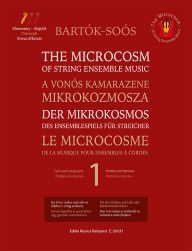Chamber Music
Of the numerous forms of collective music-making, one of the most rewarding is chamber music.
Its value is derived not only from the more complex musical texture, but from the challenge and pleasure of making music together. Moreover, it has benefits in terms of socialized thinking because it requires players to accept each other musically and cooperate to produce music.
As such, chamber music has gained a significant role in music education and this has been recognized by most music schools in the world. Music publishers, including Editio Musica Budapest, have also produced a wide range of scores.
Hungarian musicians have won recognition among countries with long-established musical cultures because of the high quality of Hungarian music education. Music teachers have produced excellent tutors and collections of character pieces, and at the same time they have paid attention to chamber music playing as well.
The series presented here have proved their value over the years in terms of both quality and popularity. This experience gives us the courage to recommend them wholeheartedly and enthusiastically not only to teachers and students but to amateur musicians as well.
The Microcosm of String Ensemble Music
Mikrokosmos is perhaps the 20th century's most influential set of piano pieces and one of the milestones in pedagogical piano repertoire. These 153 piano pieces, organized in ascending order of difficulty, engage not only with technical aspects of piano playing but also with the fundamentals of composition. In addition, they include character pieces and even pieces with programmatic ideas.
''The Microcosm of String Ensemble Music'' by András Soós provides 148 transcriptions from this series for making music for various string ensembles and graded in four volumes according to level of difficulty. Volumes 1 to 3 also include one copy of each part in addition to the full score. For performances with orchestra, further printed parts can be ordered individually.
The parts are also available online at www.digikotta.hu, where they can be viewed and downloaded for free as A4 PDF files using the individual code printed in the volumes.
Recordings are available at our YouTube channel.
Treasury for String Ensembles
Treasury for String Ensembles provides carefully selected original compositions and arrangements from the Renaissance to the twentieth century, compiled in volumes according to level of difficulty, from beginner’s level to professional.
Elementary (all in first position): typically for three violins and cello or children’s string orchestra.
Intermediate: typically for three violins and cello or string quartet or youth string orchestra.
Advanced: typically for string quartet or string quintet (with double bass) or string orchestra.
Some volumes include works that can only be performed with an orchestra. In each case, this is indicated on the title page or in the contents.
The volumes are published in both printed and digital form. The printed edition contains the score and one copy of each part. Further copies can be ordered for the purposes of orchestral performance. The digital edition can be viewed via www.digikotta.hu, and the parts can also be downloaded as A4-sized PDF files. The digital edition comes free with the printed edition, using the unique code provided.
 Deutsch
Deutsch English
English Español
Español Magyar
Magyar Polski
Polski Română
Română Slovenský
Slovenský Slovenščina
Slovenščina 中文
中文






































































































